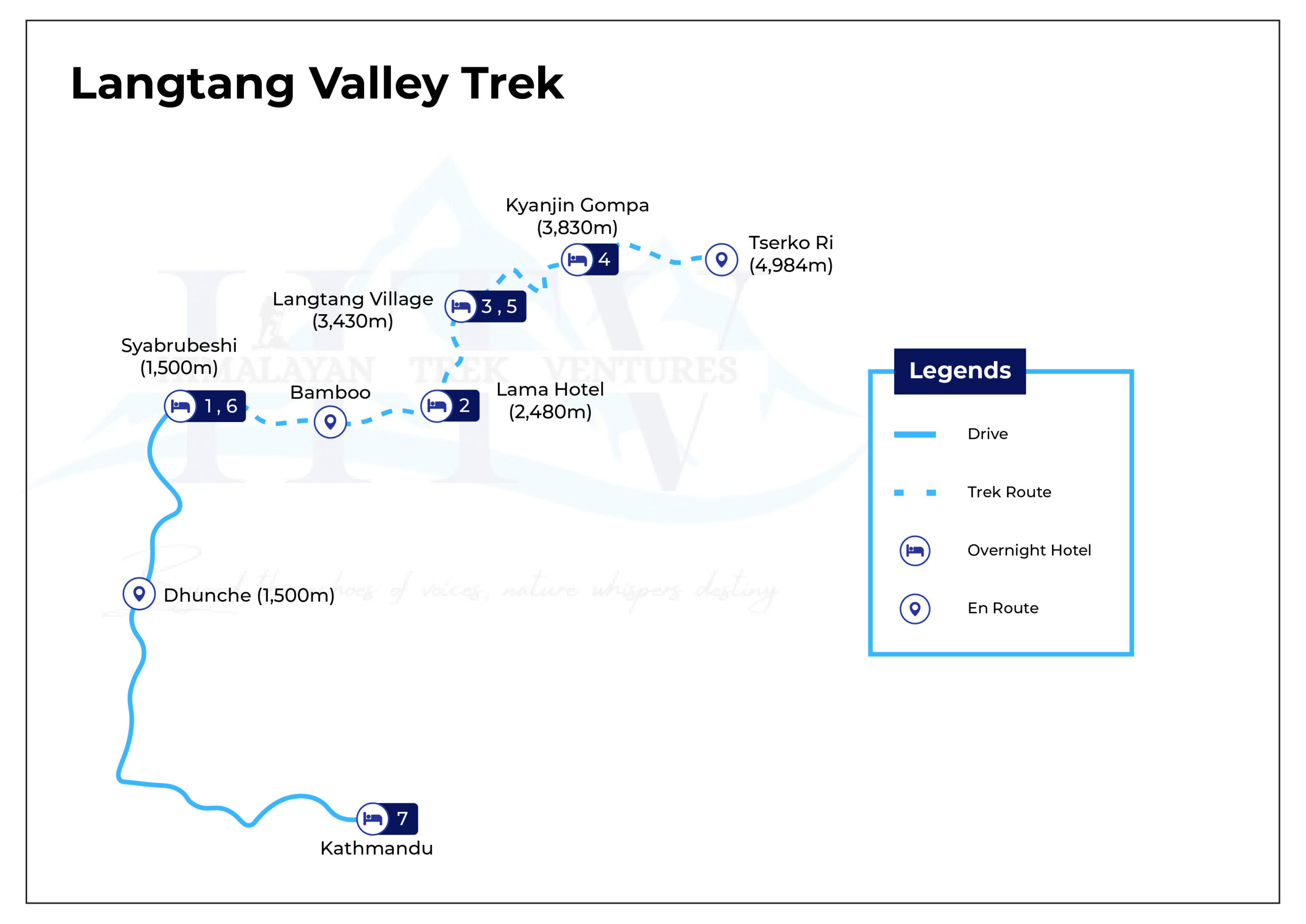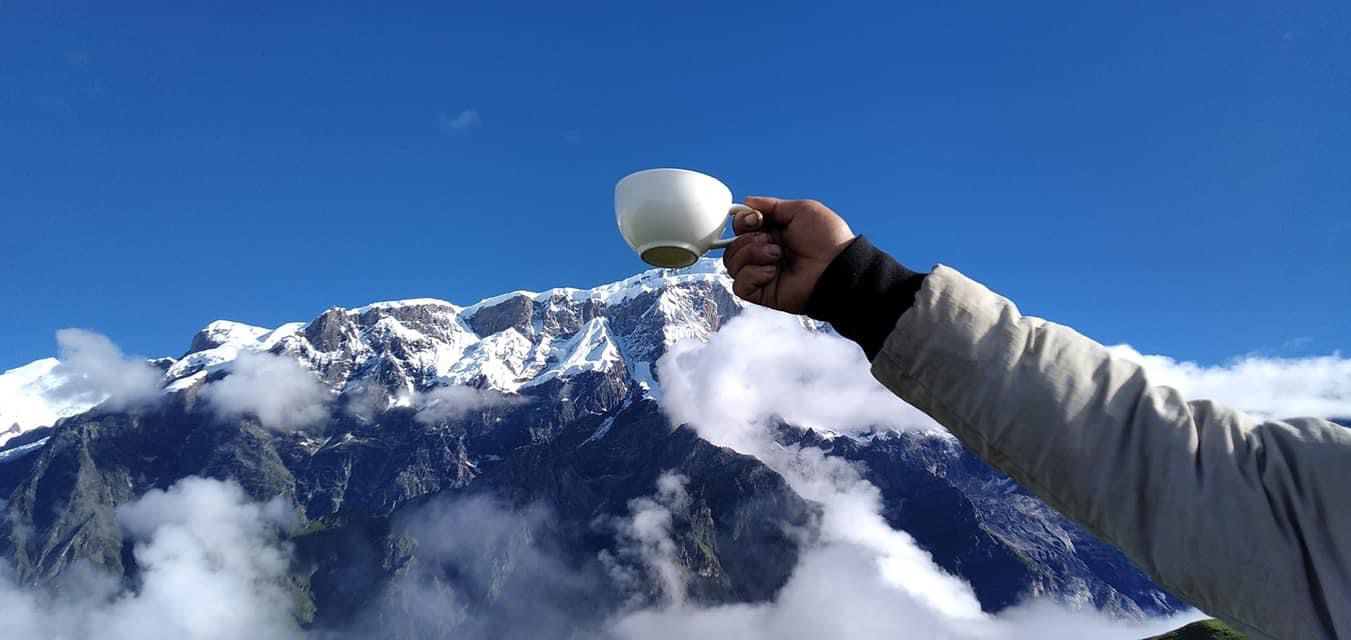Langtang Valley Trek – 7 Days
7 Days
Moderate
4,984m (Tserko Ri)
March-May and September-December
2 - 12
Langtang Valley Trek – 7 Days Introduction
“A short trek into sacred valleys where glaciers breathe and prayer flags dance to the wind’s sacred whisper.”
The 7-day Langtang Valley Trek is a short adventure, designed for trekkers who have limited time yet infinite desire for the mountains. Within a week, you’ll go from thick bamboo forests and roaring rivers to high pasture yak pastures and glacier-cradled monasteries.
Although a shorter trek, this trek showcases the best of Langtang – its raw beauty, deep Tamang culture, and towering Himalayan peaks, so it’s ideal for trekkers who want to see the high Himalayas without long itineraries or domestic flights.
Who is this Trek For?
The 7-day Langtang trek is suitable for:
- Short-time travelers who want a true Himalayan trekking experience
- Adventure travelers looking for a more laid-back, less-visited trek
- Average fitness trekkers who want to include some local culture and experience the mountains
- Students, photographers, and working professionals with a limited time frame
- All persons wanting to go trekking within a flight from Kathmandu
Being fit is beneficial, especially for the hike to Tserko Ri, although it is steep, it is totally optional.
Highlights
- Quick access to Langtang National Park from Kathmandu
- Visit and explore Langtang Village with its sacred Kyanjin Gompa
- Climb to Tserko Ri (4,984m) for unbeatable panoramic views of the Himalayas
- Walk through bamboo forests and rhododendron groves
- Enjoy the warmth of authentic Tamang hospitality in cozy mountain lodges
- Experience a full Himalayan trek in just 7 days
- No flights involved – get there with a scenic drive
Outline Itinerary
- Day 1—Drive from Kathmandu to Syabrubesi (1,550m)
- Day 2—Trek from Syabrubesi to the Lama Hotel (2,380m)
- Day 3—Trek from Lama Hotel to Langtang Village (3,430m)
- Day 4—Trek from Langtang Village to Kyanjin Gompa (3,870m)
- Day 5: Hiking to Tserko Ri (4,984m) and return to Lama Hotel
- Day 6: Trek to Syabrubesi
- Day 7: Drive back to Kathmandu
Detailed Itinerary
Day 1—Drive from Kathmandu to Syabrubesi (1,550m)
Depart Kathmandu for an incredible 7-hour drive with plenty of Himalayan views, through small villages and terraced farmland, with a scenic drive through wooded hills.
Drive time: 7–8 hours
Accommodation: Lodge in Syabrubesi
Day 2—Trek from Syabrubesi to the Lama Hotel (2,380m)
From all itinerary points onward, all travel will be within the Langtang National Park boundary! The trek begins right after breakfast. We will head past the old village of Syabrubesi and directly enter the national park. We then trek alongside the Langtang River for the rest of the day’s hike. We will be hiking through extremely dense forests well off the usual tourist path.
Trek time: 6–7 hours
Accommodation: Lodge in the Lama Hotel
Day 3—Trek from Lama Hotel to Langtang Village (3,430m)
Today’s hike will be mostly uphill, with several uphill gains and gradually gaining altitude, where we will follow the same path as before past the waterfalls, rock overhangs, and stone shelters to eventually reach Langtang Village that has been rebuilt since the last trek due to last earthquake.
Trek time: 5–6 hours
Accommodation: Lodge in Langtang
Day 4—Trek from Langtang Village to Kyanjin Gompa (3,870m)
Today’s hike is a fairly short day but incredibly beautiful hike where we will take a leisurely stroll through the alpine Yak pasture and other low-density Buddhist landscapes; hiking in the highlands today quickly feels like home!
Trek time: 3–4 hours
Accommodation: Lodge in Kyanjin
Day 5: Hiking to Tserko Ri (4,984m) and return to Lama Hotel
Up early to hit the summit of Tserko Ri for some amazing panoramic views before a long descent.
Trek time: 8–9 hours total
Overnight: Lodge in the Lama Hotel
Day 6: Trek to Syabrubesi
The last day of trekking, which will take you through beautiful forests and beside rivers.
Trek time: 5–6 hours
Overnight: Lodge in Syabrubesi
Day 7: Drive back to Kathmandu
Return by private transportation and through some beautiful Himalayan foothills (return by private transportation).
Drive time: 7–8 hours
Overnight: optional (not included)
Includes
- Private transportation from Kathmandu to Syabrubesi and return.
- All meals during the trek (breakfast, lunch, dinner).
- Teahouse accommodations throughout the trek.
- Government-licensed and English-speaking guide.
- Porter (1 porter for 2 trekkers).
- Langtang National Park Entry Permit and TIMS cards.
- First aid kit and emergency backup plan.
- Government taxes and agency service charges.
Excludes
- Accommodation in Kathmandu (available on request).
- International flights and Nepal visa fees.
- Travel insurance (mandatory).
- Personal expenses (hot showers, snacks, drinks, tips).
- Tips for your guide and porter.
- Extra gear rental (if necessary).
Trip Map

Clothing:
- Lightweight down jacket & windbreaker
- Thermal base layering & fleece
- Trekking pants & quick-dry shirts
- Gloves, sunhat, beanie, buff
Footwear:
- Comfortable boot/hiking shoe
- Warm socks and camp shoes
Gear:
- Sleeping bag (we recommend -10°C)
- Backpack (40L), headlamp
- Water bottles and purification tablets
- Sunglasses, sunblock, and lip balm
Documents & Essentials:
- Passport copy, permits
- Personal medical kit
- Small towel, toiletries & sanitizer
- Power bank (there are limited charging options)





